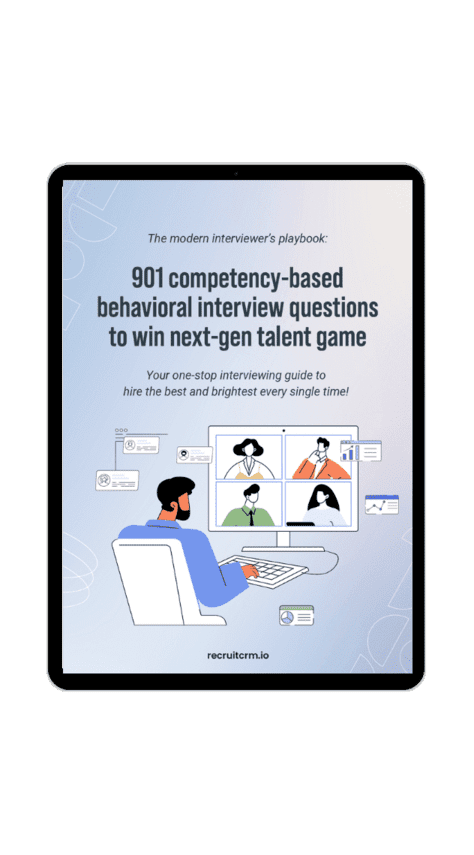If your ultimate hiring goal is to land the “perfect” placement, the key is to source candidates who are closer to your definition of perfection.
But the question is– how do you pave your way to success right from the beginning?
That is exactly where effective candidate sourcing strategies come into play.
We have carefully hand-picked a few strategies for you that work every time, just so you don’t have to.
Ready to unfold? Let’s go!
Top 8 candidate sourcing strategies for this season
1. Social media recruitment
It’s the era of social media, and there’s absolutely no way we can deny it. So, it’s only a wise decision to employ whatever it has to offer the recruiting industry and make the best out of it.
Here’s a list of platforms to target right off the bat–
- LinkedIn: Renowned as the leading professional networking platform, LinkedIn provides recruiters with unmatched access to diverse talent. Beyond basic networking, its ‘People also viewed’ feature suggests potential candidates with similar expertise. Also, its ‘Open to Work’ badge further pinpoints individuals actively seeking new opportunities, streamlining the sourcing process.
- Twitter: Twitter’s real-time nature offers a unique advantage. Instead of just posting job listings, create engaging polls about industry trends, host weekly Q&A sessions about roles in your company, or even spotlight current employees with ‘A day in the life’ tweet threads.
- Facebook: With its extensive user base, Facebook is essential for reaching a broad audience. Utilize its targeted ads to pinpoint potential talent based on demographics, interests, and more.
- Instagram: Instagram is known for its visually appealing content and that makes it the best platform for you to showcase company culture through stories, photos, and videos. You can engage with job prospects in the comments, and use the explore tab to discover trending industry-related content.
- Reddit: Often overlooked, Reddit hosts numerous industry-specific communities (subreddits) where professionals gather to discuss trends, challenges, and news. Engaging in industry-aligned subreddits, hosting informative ‘Ask Me Anything’ sessions, and keeping a pulse on popular, upvoted content can always help you discover newer talent.
Employee referral programs
Employees are the priciest assets for an organization, be it to generate revenue or bring in suitable candidates for an open position.
On top of that, let’s not forget the strong trust factor when hiring through employee referral programs.
One cool way to implement the same is to reward employees for recommending candidates who are eventually hired.
This not only motivates the workforce but also taps into their personal networks.
Use analytics to determine which employees bring in the most referrals and lead to successful hires. This data can help refine the referral program over time.
3. Leveraging recruitment software
With the world running at light’s speed – powered by the goodness of automation, you have no choice but to start using a recruitment software for optimum results.
So, what are the primary benefits of automated candidate sourcing?
- Efficiency: Automation speeds up the sourcing process, allowing recruiters to reach out to more candidates in less time.
- Accuracy: #RecTech can scan vast amounts of data to find candidates that match specific criteria, reducing the chances of oversight.
- Data-driven decisions: With real-time analytics, recruiters can make informed decisions based on trends and patterns.
Recruitment software like applicant tracking systems (ATS) or CRM systems are designed to streamline the hiring process in all the ways you can imagine.
With their intuitive interfaces, you can manage candidate pools, track communications, and automate repetitive tasks.
4. Networking and community engagement
Putting conscious efforts into spreading the word about your job openings is a truly game-changing strategy.
Here are some ways to get into the drill–
-
Leverage virtual events
- Virtual roundtables: Platforms like Run The World allow organizations to participate in digital roundtables, connecting professionals from all over.
- Digital workshops: You can set up workshops that resonate with sector-specific needs, positioning your company as an industry leader. Additionally, incorporating virtual workshop software can enhance engagement and collaboration among participants, providing a seamless platform for interactive sessions, live demonstrations, and real-time discussions.
- Interactive webinars: Host webinars about trends or challenges using video conferencing tools like Zoom, Cisco Webex, Google meet, etc.
-
Building relationships with passive candidates
- Engagement on niche platforms: Beyond LinkedIn, platforms like Stack Overflow, Behance, or GrowthHackers are rife with professionals showcasing their expertise. By actively participating, you can identify and engage with top talent even before they begin their job search.
- Alumni networks: Reaching out to universities and tapping into their alumni networks can be an effective strategy. Not only do these networks boast recent graduates, but they also encompass seasoned professionals who might be considering a career change.
-
Tap into specialized communities
Actively engage in niche forums like Quora Spaces and specific Reddit communities. Participation in these platforms can spotlight standout talent and help you build a sustainable network of job seekers.
5. Talent pools and candidate pipelines
Not every good candidate is fit for “the role,” but you never know if they are the perfect fit for another, right?
That is exactly why having a list of skilled yet rejected candidates is a recruitment best practice.
Build and maintain a database of potential candidates, including those who might not be a fit for current roles but could be valuable in the future.
Regularly engage with the talent pipelines through newsletters, updates, or personalized messages to keep them interested in future opportunities.
6. Targeted job advertisements
Curating captivating job postings is the ultimate cheat code to utilize hiring platforms to their fullest. Here are a few tips for you to ace it:
- Clear job titles: Use titles that accurately reflect the role and are commonly searched for.
- Compelling descriptions: Highlight the benefits of the role and the company culture.
- Visual elements: Incorporate images or videos to make the post stand out and engage desired candidates.
- Clarify the role beforehand: Clearly define the responsibilities and expectations. List all the essential skills and experiences that are a must-have.
- Amplify the company values: Highlight the company’s mission and values to attract like-minded candidates.
- Utilize SEO for job posts: Optimize job postings with relevant keywords to ensure they rank higher in search engine results, making them more visible to job seekers.
Now comes the part where you need to amplify these job adverts. Here’s how you can go about it:
- SEO optimization: Infuse your job postings with industry-relevant keywords. This strategy enhances their ranking on search engines, improving visibility among job seekers.
- Leverage paid ads: Use platforms like Google or LinkedIn to promote your job postings. Targeted campaigns can ensure your ads reach a specific demographic, skill set, or experience level leading to quality applications.
Campus recruitment
Freshers are often brimming with enthusiasm as they enter the corporate world, presenting recruiters with a golden opportunity to harness this energy.
Here’s how you can leverage campus recruitment effectively:
- Academic collaborations: Partner with colleges to participate in career fairs and workshops. This introduces students to your company and allows a firsthand assessment of emerging talent.
- Internship opportunities: Roll out structured internships that grant students a real-world corporate experience. These programs often serve dual purposes: they’re a talent assessment tool for recruiters and a company culture sampler for students.
- Mentorship programs: Initiate programs where seasoned professionals guide students, enhancing their skills and familiarizing them with your company’s ethos.
- Offer conversion: Recognize standout interns or training participants and consider them for full-time roles, ensuring a consistent talent influx.
8. Utilizing recruitment analytics
Statistics have always been a recruiter’s best friend.
Not only does it promote data-driven recruitment, but it also helps us understand how far we’ve come with our efforts.
The first hack is to track all the key performance indicators (KPIs).
Start by monitoring metrics like time-to-hire, cost-per-hire, and quality of hire to assess the effectiveness of sourcing strategies.
Regularly review and refine candidate sourcing methods based on recruitment analytics to ensure continuous improvement.
Major challenges associated with candidate sources and how to tackle them
1. Limited talent pool and high competition
In certain industries or for specialized roles, the number of qualified candidates may be limited.
For in-demand roles, multiple companies might be vying for the same candidates.
Adaptation strategy: Broaden the search criteria, consider candidates who might need some training, and look into other relevant industries in order to tap into job seekers with transferable skills.
Offer competitive compensation packages, emphasize company culture, and highlight growth opportunities within the organization.
2. Evolving role of employer branding
A strong employer brand is becoming crucial in attracting top talent.
Adaptation strategy: Invest in employer branding initiatives, actively manage online company reviews, and ensure a consistent and positive brand image across all platforms.
3. Budget constraints
Not all companies have the resources for extensive sourcing campaigns.
Adaptation strategy: Optimize the use of available resources, leverage free or low-cost online platforms, and consider collaborative hiring or referral programs.
4. Emergence of new trends
With the rise of AI, machine learning, and other technologies, the way recruiters source candidates is continuously evolving.
Additionally, the recent talent acquisition trend towards remote work has opened up a global talent pool.
Adaptation strategy: Invest in training and upskilling, stay updated with industry trends, and integrate new technologies into the recruitment process.
Develop sourcing strategies for remote recruitment, consider time zone differences, and ensure that company infrastructure supports remote collaboration.
5. Changing legal and compliance landscapes
With changing laws around data privacy and recruitment, companies need to be cautious.
Adaptation strategy: Stay on top of local and international recruitment laws (like GDPR), invest in legal counsel, and ensure that all candidate sourcing methods are compliant.
Frequently asked questions
1. What’s the difference between sourcing and recruiting?
Sourcing focuses on identifying suitable candidates, while recruiting involves the entire hiring process, from initial contact to job offers. Sourcing is the initial step, and recruiting encompasses subsequent stages.
2. Are job fairs still effective for candidate sourcing?
Yes, job fairs allow direct interaction with potential candidates, offer insights into the talent market, and can be especially effective for roles requiring specific qualifications or for bulk hiring.
3. How do I source candidates internationally?
Utilize global job boards, partner with international recruitment agencies, attend global industry events, and leverage platforms like LinkedIn to connect with professionals from different regions.






